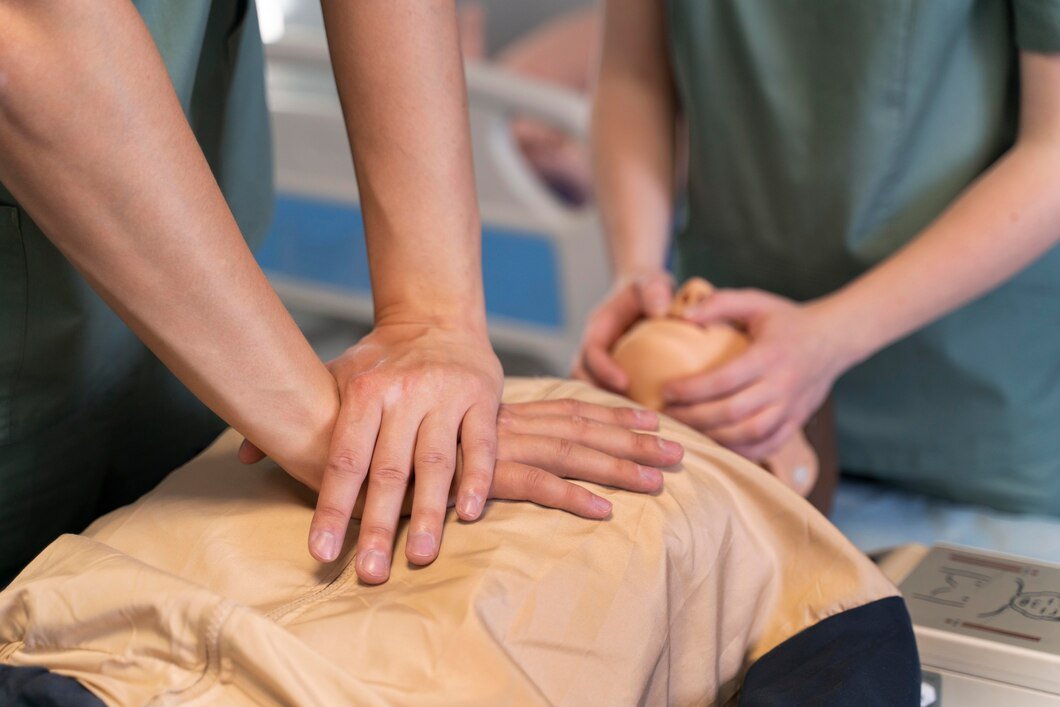Cardiopulmonary Resuscitation (CPR) is a critical life-saving technique used during emergencies when someone’s heart has stopped beating. Whether due to cardiac arrest or another medical emergency, timely and accurate CPR can double or even triple a person’s chances of survival. One of the most important factors that can impact the success of CPR is the proper CPR hand placement.
In this article, we’ll delve into the significance of correct hand positioning during chest compressions, offer step-by-step guidance, and address common questions related to the process.
Why Is Proper CPR Hand Placement Important?
CPR involves performing chest compressions to help maintain blood circulation and oxygen supply to vital organs, particularly the brain and heart, until professional help arrives. Hand placement directly influences the effectiveness of these compressions. Proper positioning ensures that the compressions are both deep enough to pump blood efficiently and delivered in the correct location on the chest.
Incorrect hand placement can result in several issues:
- Ineffective compressions: The compressions may not be deep enough to circulate blood properly.
- Injury to the person receiving CPR: Poor hand placement can lead to broken ribs or other injuries.
- Wasted energy: If the chest compressions are not aligned with the body’s natural structure, the effort may be in vain.
Understanding the optimal hand placement is, therefore, essential for both rescuers and trained responders.
How to Find the Correct Hand Placement
Knowing where to place your hands during CPR is crucial to maximizing your compressions’ effectiveness. Here’s a step-by-step guide to ensure you are positioned correctly:
1. Position the Person Lying on Their Back
To begin CPR, the person should be lying on their back on a firm surface. If possible, remove any clothing that might obstruct your ability to access the chest.
2. Locate the Center of the Chest (Sternum)
The first step in hand placement is identifying the center of the chest. Feel for the breastbone, also known as the sternum. The correct hand placement will be just above the bottom half of the breastbone, slightly between the nipples.
3. Place the Heel of One Hand
Once you’ve located the center of the chest, place the heel of one hand on the sternum. The heel of your hand should be directly on the bone, avoiding any soft tissue or ribcage. It’s crucial not to place your hand over the ribs, as this can lead to less effective compressions.
4. Place the Other Hand on Top
Now, place your other hand on top of the first hand, interlocking your fingers. Keep your elbows straight and your shoulders aligned directly over your hands. This alignment will help you apply sufficient downward force during chest compressions.
5. Ensure the Correct Depth and Rate
For effective CPR, your compressions should be at least 2 inches (5 cm) deep for adults, with a rate of 100 to 120 compressions per minute. Be sure not to release the chest fully between compressions but allow it to rise slightly to ensure full recoil.
Correct Hand Placement for Different Ages
While the basic principles of hand placement remain the same for most individuals, there are some differences depending on the person’s age and size. Let’s explore the different hand placements for infants, children, and adults.
Adult CPR Hand Placement
As mentioned, for adult CPR, the placement is typically two hands on the sternum, one on top of the other. Ensure that your arms are straight and your body weight is directly over your hands to ensure deep compressions.
Child CPR Hand Placement
For children aged 1 to 8 years, the process is similar but slightly modified. You can perform chest compressions with either one or two hands, depending on the child’s size. For smaller children, you might only need one hand to deliver effective compressions. Be sure to use your fingertips or the heel of your hand, depending on the child’s size.
Infant CPR Hand Placement
For infants under 1 year old, the hand placement is much more delicate. You should use just two fingers to perform chest compressions. Place your fingers in the center of the infant’s chest, just below the nipple line, and apply gentle but firm pressure. Avoid using too much force to avoid injury to the baby’s fragile ribs and organs.
The Importance of Correct Compression Depth
The depth of your chest compressions is a critical factor in their effectiveness. Proper compression depth ensures that the heart is sufficiently compressed to pump blood through the body. Inadequate compression depth can lead to reduced blood circulation, diminishing the chances of survival.
For adult CPR, the recommended compression depth is at least 2 inches (5 cm). For children, aim for about 2 inches, and for infants, compress the chest about 1.5 inches (4 cm). The depth should be sufficient but not so deep as to cause injury to the ribs or organs.
CPR for Special Circumstances: When Hand Placement Matters
While standard CPR hand placement works for most emergencies, there are some special circumstances where you may need to adjust your technique:
CPR in Pregnant Women
In cases of pregnancy, CPR should be performed the same way as for an adult, but the woman may need to be tilted slightly to the left to alleviate pressure on the vena cava, a large vein that returns blood to the heart. In such cases, place a pillow or rolled-up clothing under her right side to create a slight tilt.
CPR in Obese Individuals
For individuals with obesity, the chest wall may be thick, and it can be harder to achieve the necessary depth of compression. In such cases, applying extra force and using the full weight of your body can be necessary to achieve adequate compressions.
CPR After Drowning
For a drowning victim, begin CPR immediately after pulling the person from the water. Ensure that you are still placing your hands in the correct position on the chest. Remember to give rescue breaths before resuming chest compressions.
Common Mistakes in CPR Hand Placement
While CPR can be life-saving, some common mistakes during hand placement can reduce its effectiveness. Here are a few errors to avoid:
1. Placing Hands Too High or Too Low on the Chest
Incorrectly positioning your hands too high or low on the chest can lead to ineffective compressions. Always aim for the center of the chest, just above the lower half of the breastbone.
2. Pressing on the Ribs Instead of the Sternum
Make sure the heel of your hand is placed directly on the sternum, not on the ribs. Pressing on the ribs can cause them to break and can make compressions less effective.
3. Not Maintaining Proper Compression Depth
Not pushing hard enough to achieve the correct depth can reduce the effectiveness of your compressions. Ensure that your compressions are deep enough to circulate blood.
4. Inconsistent Compression Rate
The ideal compression rate is between 100 to 120 compressions per minute. Too fast or too slow can impact the effectiveness of CPR.
Conclusion: The Vital Role of Proper CPR Hand Placement
Proper CPR hand placement is essential for delivering effective chest compressions that can save a life. By following the right steps and positioning your hands on the sternum, you can help ensure blood circulation and oxygen flow until medical help arrives. Always remember to apply enough pressure to achieve proper depth, maintain a consistent rate, and adjust your technique based on the victim’s size and age.
Knowing how to place your hands correctly during CPR is not only important for rescuers but can be the difference between life and death in an emergency situation. If you’re not yet trained in CPR, consider taking a certified course to learn the proper techniques and improve your ability to save lives.
FAQs
What happens if you don’t use proper hand placement during CPR?
Improper hand placement can lead to ineffective chest compressions, which means the heart may not be adequately pumped. This can lower the chances of survival.
Can you break ribs while performing CPR?
While ribs may break during CPR, it is essential to ensure the proper depth of compressions. Broken ribs are a side effect of delivering life-saving compressions and are generally considered less harmful than ineffective CPR.
How can I check if my hand placement is correct during CPR?
You should be able to feel the sternum with the heel of your hand and ensure your elbows are straight and positioned above your hands to apply enough force during compressions.
Do I need to adjust my hand placement for children or infants?
Yes, the hand placement differs for children and infants. Use one hand for children and two fingers for infants to avoid causing injury while still achieving effective compressions.
What is the correct compression rate during CPR?
The ideal rate is 100 to 120 compressions per minute. This rate helps maintain adequate blood circulation until professional medical help arrives.











